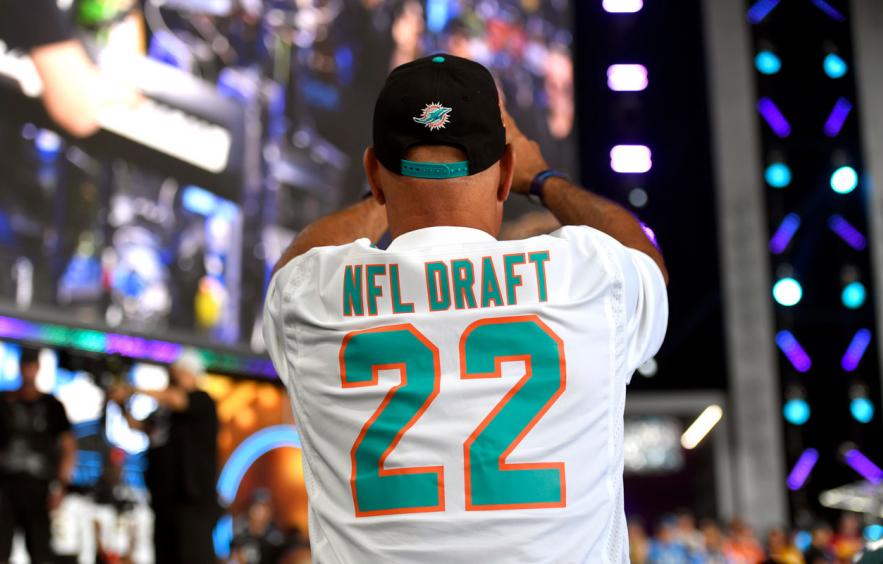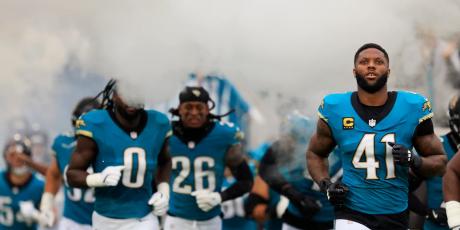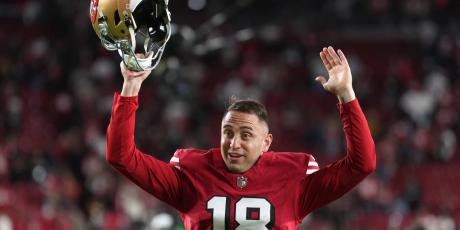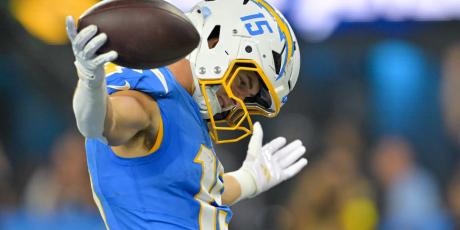How to Approach 2023 Salary Cap Drafts (Tips & Tricks)

Snake drafts are simple, easy to understand, and organized.
Salary cap drafts are not.
They are haphazard and chaotic. That’s part of what makes them so much fun.
Want Justin Jefferson? He’s yours...if you’re willing to pay. Your ideal draft strategy or roster construction can be brought to life. You’re not beholden to a certain draft slot or to the whim of the guy picking in front of you. It’s your team and the decisions you make will completely shape your roster, for good or for bad.
Other Salary Cap Articles: Studs and Scrubs | Striking at Value in Auction Drafts |
Fantasy Football Salary Cap Strategy
Salary cap leagues come in all shapes and sizes, but the most common will be a live draft with a $200 budget. With that budget, league members take turns nominating one player at a time, and the highest bidder gets to draft him. Draft night can get both hectic and stressful, especially in the early rounds, as you need to be willing to change your approach and strategy on the spot if you get outbid on a player you wanted, or strike at a player you didn't plan on drafting if their price was too good to pass up on.
I generally budget 90% of my total cap for my starters. This way, I have already accounted for some extra funds to acquire some cheap backups in the latter part of the draft. This might seem like a lot to spend on your starters, but these are the guys who are playing week in and week out, so I believe it’s smart to put the vast majority of your resources to that end. Also, remember that there will be some starter- and bench-caliber players available on the waiver wire throughout the season. This approach to spending can give you a star-studded roster with two first-round players, or up to four from the first two rounds, which would be impossible in a snake draft.
In most salary cap drafts, owners are amped up and ready to spend. Usually, big-name players are nominated first, so there is a sense of urgency when the guys that nobody wants to miss out on are on the board, and you usually don't want to reach the third round of nominations without a stud to anchor your roster. The bids come fast and furious and prices are usually inflated. How do you know if they’re inflated? 4for4's Cheat Sheet can tell you. The prices give you a maximum suggested bid for all relevant players based on your custom league scoring format, number of teams, and number of starters by position. Your goal is to try to get players you like for that price or less.
There is, however, a caveat that in less experienced leagues, or those new to salary cap drafting, you can sometimes find great value in the first round of nominations. If Austin Ekeler has a suggested bid of $61, drafters may be weary of spending over 30% of their budget on one star. What if Ekeler suffers an early-season injury or holds out? What if he plays the full season but is generally below expectations? This uncertainty can leave managers hesitant to spend big on elite assets, especially when there's still a ton of talent on the draft board. Even if Ekeler's suggested price is $61, in draft rooms like this he may end up getting drafted for $55 or less. While you should be hesitant to get too excited and overbid in the early rounds, you should also be opportunistic in grabbing star players at a discount if the draft room allows for it.
When approaching a salary cap draft there are three prevailing strategies to consider when bidding on players:
Studs and Scrubs
I've written about Studs and Scrubs before, as it's a favorite among many passionate salary cap drafters. This approach is to hit the draft hard at the start, acquiring two to four top players—first or second-rounders in a traditional draft format–that cost anywhere from 50 to 80% of your total budget. While you need to trust your price targets, don’t be afraid to pay a bit more than MSRP to get a guy you want.
Once you have your first few players, look to round out your roster with cheaper assets, hoping your studs will stay healthy and carry you to the playoffs. Depending on how far you pushed your payroll, this may be easier said than done. Owners who saved their money for the middle of the draft are going to be able to outbid you at will, so you have to hope that those owners aren’t interested in the cheaper players that you want. If you’re patient, you can usually find good deals in the later stages of the draft. This can often include young wide receivers, valuable late-round quarterbacks, or running backs that find themselves in a timeshare but can provide a breakout opportunity.
When getting into the final rounds with really cheap players I prefer to target high-upside talent. The third wide receiver on an average offense isn't likely to earn a starting spot in your fantasy roster, and may even get dropped in the first month of the season. Instead, look for players with league-winning potential, where taking the lead role in the offense is a real possibility. If things don't pan out you can still drop them after the first few weeks.
This is a high-risk, high-reward strategy. But if you're disciplined in your approach and spending, you can give yourself a serious edge once the season kicks off.
Sit and Wait
Another approach is to sit on the sidelines while the other owners trip over themselves overbidding every player on the board. At some point, they’ll all run out of money having overspent on their studs, and won’t have any money left to fill out the rest of their roster with anything but scrubs.
This is the point in the draft—usually when 60 to 70% of the total league payroll has been allocated—where you can strike. This is when you step in with your wad of cash and pounce on value when it reveals itself. It’s not uncommon for good players (players going in the third through the fifth round of regular redraft leagues) to go for 50% or less than their projected value. The strategy here is to build a balanced squad made up of solid mid-round talent. This type of team will be better able to absorb an injury or two, although I still recommend having one or two weaker spots in your starting lineup that could be set to benefit from smart waiver or trade activity.
There are two drawbacks to this strategy: 1) fantasy champions usually have at least one or two studs on the roster and 2) it can be difficult to sit idly by at the start of the draft as a series of very talented players come and go.
Both strategies, if followed to the letter, have significant drawbacks. This is why I advocate something of a hybrid approach, which I dubbed...
The Hybrid Approach
Clever, I know. This strategy requires the manager to play a little defense in addition to offense. The first thing I do is nominate a player I don’t really want. The ADP Draft Day Sleepers tool can help to identify overvalued players. Just hit the Bargain Score column until the negative numbers come to the top. Look for a big-name player going in the first or second round. Throw his name out there and, hopefully, you can cause a feeding frenzy, eating up some of the resources of the other owners in the league. This will also burn a starting roster spot and decrease demand for comparable players nominated later. I’ll usually cap my bid at 50 to 60% of the player’s value so that no one gets a screaming deal.
Then, as the big-name players are nominated, I’ll bid them up to different levels depending on how strongly I feel about them...60 to 70% of the maximum suggested bid if I’m lukewarm...70 to 80% if I like them...80 to 85% if I really like them...90 to 100% if I love them. You can also toss your feelings aside and target players who are being drafted cheaper than their ADP peers, they'll be there in every draft.
Sometimes, I’ll end up with a high bid on two to three big-name players early on. Don’t be afraid to spend a good chunk of your payroll on discounted studs. If you can get three first-round or early-second-round players for 60 to 75% of your total payroll, you'll be in good shape. Two studs at 45 to 50% of your payroll is also a good start. Then just lay low for a while. Only enter the fray if there is a value player available that fits your budget.
If you don’t end up with any studs in the first third of the draft, don’t fret. There are bound to be several first- and second-round talents still available, along with plenty of players who are going in the middle rounds of snake drafts. Keep track of who has and who hasn’t been nominated and only bid with a sense of urgency if the last stud running back or receiver becomes available. Chances are, you’ll be able to get him at a price that wasn’t available earlier in the draft.
Tips & Tricks to Dominate Your Salary Cap Draft
I’ve compiled some of my favorite salary cap tips and tricks below.
Study Your League's Draft History
Looking at Average Draft Values (ADV) at different sites can be helpful. It's especially helpful to look at the ADV of the site that hosts your league, since the other owners may be influenced by the recommended bid prices provided by the site. But the most useful ADV is that of your specific league. Even if you only have one or two year's worth of data, you can get a pretty good picture of how your league values each position and you can estimate what sort of bid it will take to win a particular player. Let's say that you want to acquire Jaylen Waddle, and you know he's typically the 11th receiver off the board in 12-team PPR formats. Look at the two or three-year average of your league's draft. What did the 11th-most expensive receiver go for? That's the starting point for what you can expect to pay for Waddle in your draft. That's not your maximum bid, just a good estimate. If you're trying to put a draft plan together it can be very helpful to know the estimated prices for your targets at various positions.
Don't Be the Host
Live salary cap drafts will need somebody to take nominations, keep track of the highest bid, declare when a player is "sold", and write down the player, price, and team. Don't be that guy; it's going to take you away from thinking about your team and studying what the other managers are doing and it's a thankless job. If you want to be the best manager, stay focused on the job at hand and let someone else run the draft.
Focus on Starters and Skill Players
Don't worry about backup TEs and kickers. If your league allows you to freely work the waiver wire, don't even bother bidding for a backup kicker or a backup defense. Save that cash and land another player with higher upside. Remember, injuries often pave the way for NFL stars to emerge. Having a well-targeted sleeper running back at 2% of bankroll is much better than having a journeyman backup kicker at 1%.
Always Nominate With the Minimum Bid
Owners could open bidding at five percent of their bankroll and then nobody else bids on the player. For all we know, that manager could have landed the player for 3%.
Calculate the Maximum Bid of Your Competition
Toward the middle of the draft, knowing the maximum the other managers can bid can be very helpful. If your draft is online, many sites will calculate and show this automatically. In a live draft, you can calculate live with a simple spreadsheet, apply this formula to each team:
1 + remaining bankroll - # of positions left to fill
Assuming the minimum bid is $1, if a player has $22 remaining and has 10 roster spots to fill, the most he can bid on any single player is $13. With this data live on your computer you can quickly see the maximum anyone can bid. In addition, you can see exactly how aggressive each manager can become.
Feed the Mistake
If two managers get into a bidding war over a player and one eventually overspends, then nominate a similar or even better player at the same position. This works beautifully when you want managers to continue overspending. The manager that lost on the last bid will be even more excited to land a better player at the same position. Others, while they would never admit it and may not even realize it, have been influenced by the bidding war they just witnessed.
Start by Nominating Players You Don't Want
Early in the draft, nominate players you don't want and who are overvalued. Use the ADP Draft Day Sleepers tool to find them. These are players ranked very high using ADP, but not so by 4for4. Nominate these players early and watch all the other managers bid for them, burning up their bankrolls. If you can get the other teams to eat up extra cap dollars early, you'll be in control down the line.
Use "Jump Bids" to Throw Off the Competition
If a player you like is nominated, consider using a "jump bid", which is increasing the bid by more than the usual $1 increment. Psychologically, there's a tendency in these drafts for bidders to become more comfortable with a player's rising price since the bids rise incrementally (i.e. slowly) and they know there are one or more other owners comfortable with the player's price. When the price jumps significantly and rapidly, those owners may not reassess the player's price and you can get him for a discount. For example, say there's a receiver that you like, and you peg his value at $18. Someone else nominates the player for $1, and you immediately bid $10 or $11. If the league doesn't react quickly and increase the bid, you may get the player at a significant discount.
Don't Wait for the Last Stud in a Tier
If you want an elite receiver and feel there are six on the board, don't wait until the first five are gone. At that point, other managers may also realize that only one stud WR is left and a bidding frenzy could result. I've written about this extensively in my Rule of One article.
Start the Run, Don't Finish It
In some salary cap drafts, there will be a run at a particular position. In the beginning, it's often the running back or wide receiver positions. In the middle of the draft, it’s usually the tight ends or quarterbacks. Late in the draft, it can be the defenses. In general, you're better off starting the run than being the one finishing it. At the end of the run, the talent at the "hot" position is usually two or three tiers lower.
Don't Panic If You're Outbid Early
It can be unnerving if you're nine or ten picks into the draft trying to be patient when all the other managers are clearly overpaying. They will have great stars to anchor their starting lineup while you don't have a single roster spot filled. Don't panic, the math will eventually come to your rescue and put the odds in your favor.
Monitor the Aggressiveness of Your Draft
You should know what kind of draft you’re in by the time the first few players fall off the board. Keep a running total of what players are going for and divide that by their total maximum suggested bids. If the number is greater than 1.1 (110%), then you're in an aggressive league (or at least there are a few aggressive owners). If it's less than 0.9 (90%), you're probably in a passive league, so look to invest in discounted studs early on.
Don't Get Emotional
I've seen managers lose a few bids early, smoke starts coming out of their ears, and then really lose it on the next few players. Don't go on tilt. In fact, if you have a hothead in your group, you can often bait them into this type of overspending. Be careful when bidding players up because you might just get stuck with him.
Fill It, Then Nominate It
If you're one of the first guys to fill your starting lineup requirement at a given position and if you're strong at the position, then be sure to nominate plenty of other players at that position. The logic is simple, let the other owners spend money at that spot in a potential bidding war. After they burn off bankroll you'll be better positioned to work on your other starting lineup requirements.
Invest in Training Camp Battles
In regular serpentine drafts, managers usually avoid players in a training camp battle. Why burn a draft spot on an uncertain player and then wait for five or ten picks until you get your next one? In salary cap leagues, it’s more palatable to acquire the two guys competing for the job. The reason? Salary cap drafts tend to be top-heavy. In other words, the top few guys demand huge bids. After the elite guys, the player values tend to drop off very quickly. The two guys in the training camp battle tend to be devalued in salary cap leagues so they can be had on the cheap. Yet, if one of the players finally emerges, his value grows exponentially and you come out ahead (e.g. draft an RB1 for $5 and RB2 for $3, if the RB1 is named the starter, his value will be much more than the $8 you invested).
In a Slow Draft, Don't Bid on a New Player if You're About to Win Another Player
If you’re a high bidder on a player and his timer is almost complete, wait until that auction is done before placing another bid. That way, you'll avoid freeing up money for another owner to bid up the player you're about to get.
Let Someone Else Overpay for a Kicker
Your goal should be to get a good kicker with a minimum bid. One trick is to nominate a kicker with a minimum bid early in the draft. You'll often win the draft as your competition is focused on other positions.
Stream Defenses or Look for Defensive Bargains
Expect to pay the minimum bid on a defense. If you are comfortable with using the waiver wire to change your defenses week to week, look for a mediocre defense with good matchups early in the season and spend no more than $1.
How to Approach 2023 Salary Cap Drafts
Generally speaking, a player’s ADV will closely follow his ADP, so if a certain player looks like a bargain in snake drafts, he’s likely to be a bargain in salary cap drafts as well.
Below is a table that should be useful for those owners who don't have access to their league's draft history. I compiled draft data from Yahoo and eyeballed the % of Budget range and calculated the average on a round-by-round basis. Notice that there is some overlap in the ranges.
| Round | % of Budget | Average |
|---|---|---|
| 1 | 24%-34% | 28.2% |
| 2 | 15%-24% | 19.5% |
| 3 | 10%-18% | 14.5% |
| 4 | 5%-12% | 8.6% |
| 5 | 3%-7% | 5.5% |
| 6 | 2%-5% | 3.4% |
| 7 | 1%-3% | 2.5% |
| 8 | 1%-2% | 1.6% |
| 9 | 1%-2% | 1.3% |
| 10 | 1% | 1.0% |
As an example, to estimate what A.J. Brown might go for in a $200 salary cap draft, we can take his ADP (early second round) and see that he should go in the 15 to 24% range with 19.5% as a best guess. So we can plan on Brown going for $30–$48 with $39 as a reasonably likely winning bid.
Important Note: Prices are going to fluctuate from site to site and from league to league, as owners are influenced by a variety of factors, including league size, scoring, roster size, and starting lineup requirements. The best way to determine how your league values certain positions is to look at your league's draft history. Three-plus years is ideal, but even if you only have 2022 draft results, they can help to estimate how your draft is going to go. For more detail, read the "Study your league's draft history" tip above.























